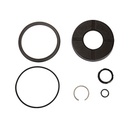Pneumatic cylinder
Pneumatic cylinders: Efficient drive solutions for automation
Pneumatic cylinders are key elements in modern automation technology and play a decisive role in the implementation of precise and repeatable motion sequences in industrial applications. At FILCOM you will find a comprehensive selection of high-quality pneumatic cylinders and matching accessories.
Functionality and design
These cylinders use compressed air as a means of propulsion and typically consist of a cylinder tube, a piston and a piston rod. The pressure of the supplied air moves the piston in the cylinder tube, which extends or retracts the piston rod. A distinction is made between two types:
- Single-acting cylinders: These work in one direction and usually use a spring for return - ideal for applications that require support in one direction.
- Double-acting cylinders: These cylinders work in both directions and therefore offer more flexibility and control for complex applications.
Types and areas of application
Pneumatic cylinders are available in different versions, which offer specific advantages for various applications:
- Standard cylinders: These comply with international standards such as ISO or DIN and are versatile and easy to replace.
- Compact cylinders: Thanks to their compact design, they are perfect for tight spaces and offer high performance.
- Round cylinders: These are characterized by their lightweight and cost-effective design and are often used in less demanding applications.
Pneumatic cylinders can be used in a wide range of applications, from manufacturing technology and the packaging industry to robotics and food production. Choosing the right cylinder requires a careful analysis of the specific requirements and operating conditions.
Criteria for selection and advantages
Various criteria are decisive when selecting the ideal pneumatic cylinder:
- Operating pressure: The maximum pressure of the cylinder should be compatible with the compressed air system used.
- Stroke and piston diameter: These parameters determine the range of movement and the available force.
- Design and dimensions: The cylinders must fit into the spatial conditions of the application.
- Materials and seals: Different materials and sealing systems are required depending on the operating environment.
- Mounting options: Varying mounting types, such as flange or base mounting, offer individual customization options.
Pneumatic cylinders are a preferred choice in automation due to their reliability, long service life and easy maintenance. The use of compressed air as a means of propulsion minimizes the risk of fire and explosion and enables high speeds and precise motion control. Careful selection and integration of the right pneumatic cylinders make a decisive contribution to the efficiency and productivity of your machines and systems.




